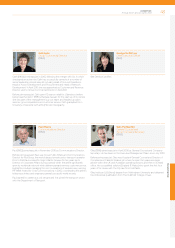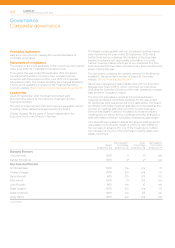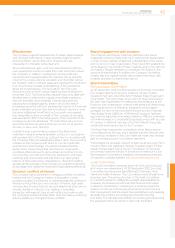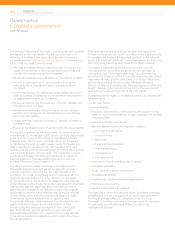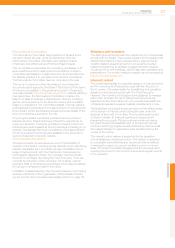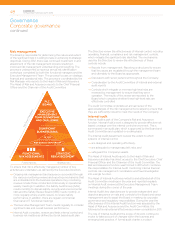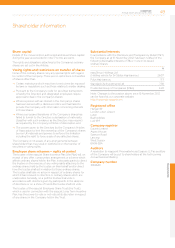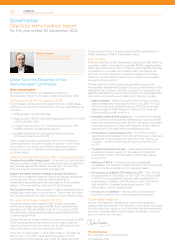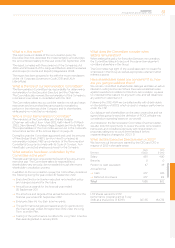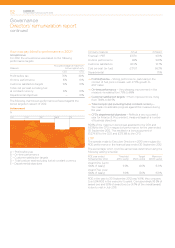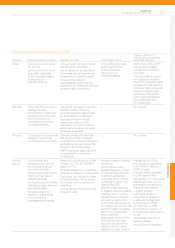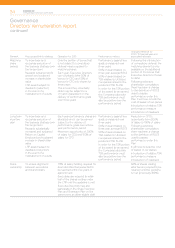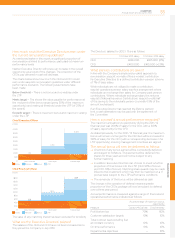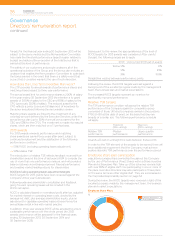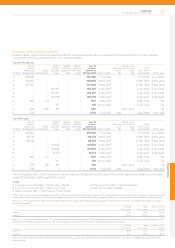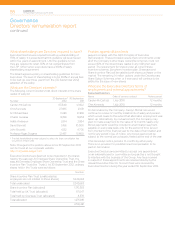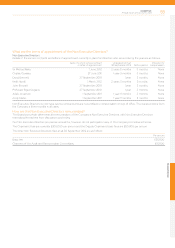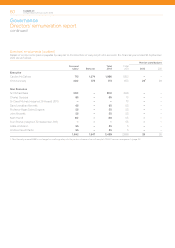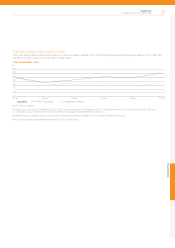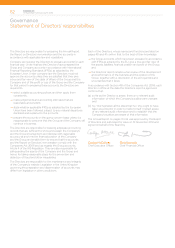EasyJet 2012 Annual Report Download - page 55
Download and view the complete annual report
Please find page 55 of the 2012 EasyJet annual report below. You can navigate through the pages in the report by either clicking on the pages listed below, or by using the keyword search tool below to find specific information within the annual report.
How is remuneration structured for 2013?
Element Purpose and link to strategy Operation for 2013 Performance metrics
Changes effective for
2012 / 13 financial year and
associated rationale
Salary To provide a core reward
for the role
Sufficient level to recruit
and retain individuals
of the necessary calibre
to execute our
business strategy
Annual review with any change
effective from 1 October
Set by reference to companies
of a similar size and complexity
targeted at or around median
Scope of the role and
responsibilities, performance,
experience and potential retention
issues are also considered
None, although overall
performance of the
individual is taken
into account in
reviewing salaries
Neither the CEO or CFO
has received a salary
increase since joining in
July 2010
The CEO will not receive
an increase at this time.
The CFO received a salary
increase of 2.5% effective
1 October 2012, in line with
those across the wider
workforce. This results
in the following salaries:
CEO £665,000 and
CFO £410,000
Benefits In line with the Company’s
strategy to keep
remuneration simple and
consistent, the Executive
Directors receive no
conventional executive
Company benefits
Executives can pay for voluntary
benefits, where Company
purchasing power may provide
an advantage to employees
Executives receive modest
personal accident and life
assurance cover (0.5 x salary),
at the same levels as the wider
employee population
– No change
Pension To provide employees with
long-term savings via
modest pension provision
Defined contribution plan with
the same monthly employer
contributions as those offered to
all eligible employees below the
Board of 7% of basic salary
HMRC approved salary sacrifice
arrangement for employee
contribution
– No change
Annual
bonus
To incentivise and
recognise execution of
the business strategy
on an annual basis
Rewards the achievement
of annual financial and
operational goals
Compulsory and voluntary
deferral provides alignment
with shareholders
Bonuses subject to
clawback (repayment)
in the event of a
misstatement of results
Maximum opportunity of 200%
of salary for CEO and 150% of
salary for CFO
One-third subject to compulsory
deferral into shares for three years
Executives can choose to defer
a further portion of their bonus
into shares which is subject to
matching
The remainder of the bonus will
be paid in cash
Primary measure is profit
before tax
Performance is also
assessed against a range
of operational measures –
customer satisfaction,
operating costs, on-time
performance and in the
case of the CFO
departmental objectives
In addition, there is a safety
underpin which must be
satisfied before bonuses
are paid, under this the
Committee will review the
Company’s record over the
period in relation to safety
and, in the event that it
was considered
appropriate to do so, the
Committee may scale
back the bonus earned
based on performance
against the other metrics
Rebalancing of CFO’s
annual bonus opportunity
from 100% of salary to
150% of salary
(corresponding decrease
in LTIP opportunity)
Introduction of compulsory
deferral element with no
potential for a matching
element to be earned
Tougher targets
with higher levels of
performance required
(relative to budget) and
a lower payout (90%
of maximum vs. 85%
previously) for delivery of
the threshold performance
target
Introduction of a formal
safety underpin
Introduction of clawback
Governance
easyJet plc
Annual report and accounts 2012 53


